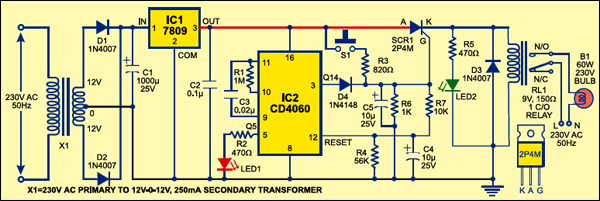 When voltages suddenly changes, the change is not smooth, it may go on fluctuating for a short while. This may not be a good for the fridge compressor for example. So, to guard such devices, a short delay is introduced while switching on until the steady state voltage is assured. This time delay circuit can help you protect your home appliances from voltage spikes.
When voltages suddenly changes, the change is not smooth, it may go on fluctuating for a short while. This may not be a good for the fridge compressor for example. So, to guard such devices, a short delay is introduced while switching on until the steady state voltage is assured. This time delay circuit can help you protect your home appliances from voltage spikes.
Time Delay Circuit

At the heart of the circuit is IC CD4060, which consists of two inverter gates for clock generation and a 14-bit binary ripple counter. Here the clock oscillations are governed by resistor R1 and capacitor C1. In this circuit, only two outputs of the IC (Q5 and Q14) have been used. Q5 is connected to an LED (LED1) and Q14 is used to trigger the gate of the SCR through D4 as well as reset the counter.
The anode of the SCR is connected to +9V and the cathode is connected to the relay coil. The other pin of the relay coil is connected to the negative supply, while its contacts are used for switching on the appliances.
Whenever power to the appliances is switched on or resumes after mains failure, the oscillator starts oscillating and LED1 blinks. This continues for three minutes. After that, Q14 output of IC CD4060 goes high to trigger the gate of the SCR through D4. At this moment, the voltage is available at the cathode of the SCR, which energises the relay coil to activate the appliance and LED2 glows. Switch S1 is used for quick start without waiting for delay.
The article was first published in June 2005 and has recently been updated.







